Environmental Protection Supervising Fisheries Biologist (35 Hour
Fisheries Division
Recruitment #190104-0214EE-001
| Location |
Burlington, CT
|
|---|---|
| Date Opened | 1/7/2019 2:10:00 PM |
| Salary | $71,339 - $102,279/year |
| Job Type | Open to the Public |
| Close Date | 1/18/2019 11:59:00 PM |
Introduction
The State of Connecticut, Department of Energy and Environmental Protection (DEEP) is charged with conserving, improving and protecting the natural resources and the environment of the state of Connecticut as well as making cheaper, cleaner and more reliable energy available for the people and businesses of the state. The agency is also committed to playing a positive role in rebuilding Connecticut’s economy and creating jobs – and to fostering a sustainable and prosperous economic future for the state. The Department of Energy and Environmental Protection (DEEP) is dedicated to conserving, improving and protecting our natural resources and the environment and increasing the availability of cheaper, cleaner, and more reliable energy.
DEEP's Bureau of Natural Resources, Fisheries Division, has a current opportunity for a Supervising Fisheries Biologist based in Burlington, CT. The Department is seeking expertise in coldwater fish culture, fish pathology, program oversite, and project management to directly supervise the operations of Burlington Fish Hatchery, and to also supervise the Fish Hatchery Supervisors in charge of the state’s two other production salmonid hatcheries (Quinebaug Valley in Plainfield, and Kensington in Berlin). The selected candidate will serve as the functional statewide Supervisor of CT’s Fish Hatchery system and also serve as the department’s expert in respect to fish health, fish disease and fish pathogens.
The Fisheries Division operates three salmonid production hatcheries, Burlington State Fish Hatchery (Burlington), Quinebaug Valley State Trout Hatchery (Plainfield), and Kensington State Fish Hatchery (Berlin). The staff at these hatcheries are charged with hatching, rearing, and distributing over 700,000 catchable size trout and salmon annually and also providing additional eggs, fry and fingerlings to support various Fisheries Division management goals.
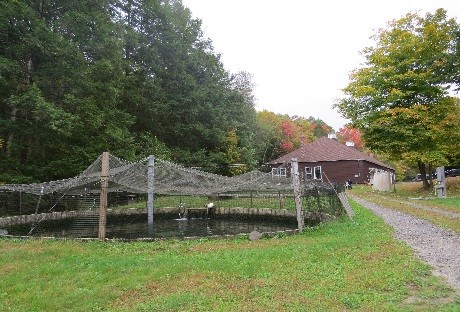
The Burlington State Fish Hatchery was constructed in 1923, making it our oldest operational fish hatchery. Burlington is a surface water and artesian well water hatchery where we currently raise domestic strains of brook, brown and rainbow trout, supplied by Quinebaug Hatchery. In addition, the hatchery supports our Farmington River survivor strain Brown Trout program, in which brood stock are collected from the West Branch Farmington River each fall, and transferred to the hatchery for final maturation and spawning, and then released back into the river. The progeny are stocked approximately one year later. This program produces hatchery trout that more closely mimic the behavior of wild trout, are more temperature tolerant, have better avian predator avoidance, and will be able to reproduce successfully on their own. The Burlington State Fish Hatchery is the only State hatchery that rears Kokanee Salmon fry, again using brood stock collected in the fall in select coldwater lakes. Finally, we are also supporting a sea-run Brown Trout program at Burlington Hatchery, using a clean source of pure sea-run eggs (Iijoki strain) that are imported annually from Finland.
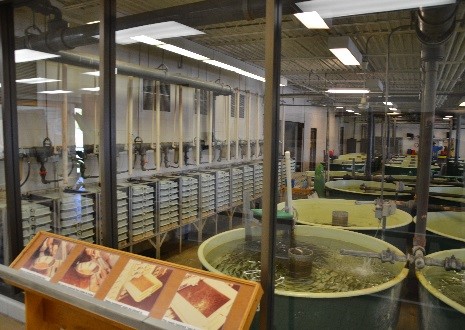
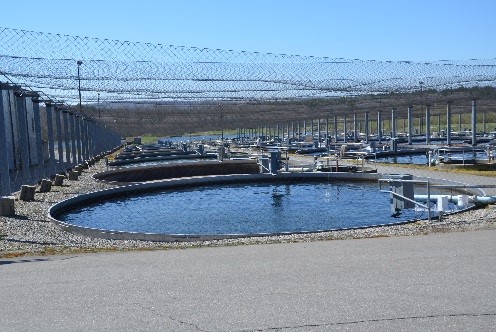
The Quinebaug Valley State Trout Hatchery is one of the largest trout production facilities on the East Coast. It is a pumped well facility built in 1971 with renovations done in the mid 1990’s. Additional modernization and energy efficiency upgrades are underway currently. The hatchery is supplied by 13 active wells that each produce 100-500 gallons per minute (gpm) and water recirculation pumps that can provide up to another 1,500 gpm. This quantity of water allows the facility to produce an estimated 380,000 pounds of trout for distribution throughout public waterways in Connecticut and three million eggs. We maintain brood lines for Brook, Brown and Rainbow Trout at this facility and raise all three species, as well as tiger trout (Brown Trout x Brook Trout). Quinebaug Hatchery also belongs to the National Brood Stock Registry. The Quinebaug facility supports Trout Unlimited’s Trout in The Classroom project by providing Brown Trout eggs to over 100 schools in Connecticut each year (eggs are distributed from Kensington Hatchery).
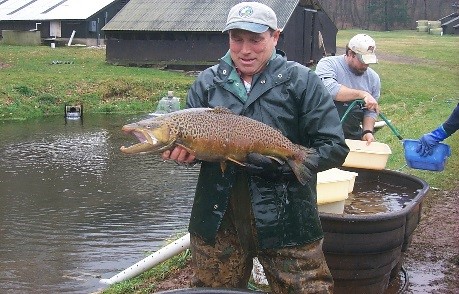
Constructed in 1934, the Kensington State Fish Hatchery is a pumped well facility and is our second oldest hatchery in operation. Kensington Hatchery was formerly dedicated exclusively to supporting the Connecticut River Atlantic Salmon Restoration program, but when the Federal agencies and other basin states efforts were terminated (2013), CT DEEP began an Atlantic Salmon “Legacy Program” supported by the hatchery. The legacy program will maintain enough Atlantic Salmon at the hatchery to preserve genetic integrity of the Connecticut River strain, which is currently the southernmost population of Atlantic Salmon in North America. Each year, surplus salmon brood stock and 2-3 year old salmon (raised specifically for this fishery) are released into the Naugatuck and Shetucket Rivers as well as selected lakes to provide a unique angling opportunity for these desirable and trophy size fish. The hatchery also provides eggs to over 80 schools that participate in the Connecticut River Salmon Association’s Salmon-In-Schools program. The hatchery is also used currently to raise catchable size Cortland Strain Brown Trout. A special Seeforellen Brown Trout strain that was formerly raised at the hatchery will be raised again at Kensington in future years.
This position is typically first shift, but hours may vary according to out of office or out of state meeting needs, or due to weather related emergency conditions.
Applicants must include a resume within the "Resume Tab" of their application.
Questions about this position should be directed to the hiring agency's human resources office: DEEP.HumanResources@ct.gov, (860)424-3006.
Selection Plan
This position is competitive. Open to the public.
The selected candidate must have a valid driver's license.
PURPOSE OF JOB CLASS (NATURE OF WORK)
EXAMPLES OF DUTIES
Schedules, assigns, oversees, and reviews work of staff; provides staff training and assistance; conducts performance evaluations; determines priorities and plans unit work; establishes and maintains unit procedures; develops or makes recommendations on development of policies and standards; acts as liaison with other operating units, agencies and outside officials regarding unit policies and procedures; prepares reports and correspondence; prepares plans for fish and waterlife programs; conducts biological research into life history, habits and rate of exploitation of various aquatic species including marine and anadromous fishes and intevertebrates; coordinates collection of data on physical characteristics of lakes and ponds; reviews limnological and oceanographic studies for fishery conservation; conducts studies to evaluate results of harvesting fish and other aquatic life; may conduct and analyze social-economic research on recreational and commercial use of aquatic resources; makes recommendations regarding distribution of fish; submits recommendations for developing rules and regulations governing sport and commercial fishing; acts as consultant to private landowners in matters concerning management of aquatic life; may inspect water management projects to determine effects on aquatic life; performs related duties as required.
This specific position:
Serves as the supervisor of the Fish Hatchery Supervisor 1 assigned to Kensington Fish Hatchery and the Fish Hatchery Supervisor 2 assigned to the Quinebaug Valley Trout Hatchery, scheduling, assigning, overseeing and reviewing their work.
Serves as the supervisor of Burlington Fish Hatchery, scheduling, assigning, overseeing and reviewing the work of three or more Maintainers and several Seasonal Resource Assistants.
Serves as the lead liaison for the Fish Hatchery system in coordinating with Inland Fisheries Management Program staff concerning production schedules and prescriptions for all salmon and trout cultured in our hatcheries.
Submits recommendations for developing rules and regulations governing the fish health aspects of the state’s cultured and wild sport and commercial fishes.
Prepares plans for fish hatchery system, serving as the Division lead for all capital improvement projects across the three-hatchery state hatchery system, and at the Wildlife Necropsy and Fish Pathology Laboratory in consultation with Hatchery Supervisors and the Division Director.
Serves as the Division lead at Intra-agency Field Operations meetings.
Serves as the primary fish health specialist for the State Fish Hatchery system; conducting biological research, including preparing and testing biological samples for pathogens, parasites and disease in accordance with the Northeast Fish Health Guidelines.
Makes recommendations to the Division Director concerning the disposition of cultured fish in the state fish hatchery system testing positive for diseases or pathogens of concern.
Reviews and acts upon all proposed importations of live fish products that require issuance of a Fish Liberation Permit from the Fisheries Division for the purpose of safeguarding the state’s free swimming and wild fish populations from pathogens and disease.
Represents the State of Connecticut on the Northeast Fish Health Committee and on the Northeast Fish Culture Chiefs Committee.
KNOWLEDGE, SKILL AND ABILITY
MINIMUM QUALIFICATIONS - GENERAL EXPERIENCE
Fisheries management is defined as work requiring a knowledge of scientific fields such as biology, ichthyology, fisheries science, fish population dynamics, aquatic ecology, limnology, fish taxonomy, fishery statistics, aquatic entomology, aquatic phycology and oceanography.
MINIMUM QUALIFICATIONS - SUBSTITUTIONS ALLOWED
2. A Master's degree in fisheries management as defined may be substituted for one (1) additional year of the General Experience.
PREFERRED QUALIFICATIONS
At least three years of experience in the operations of pumped well hatcheries or surface source water hatcheries, particularly coldwater fish (i.e., trout, salmon) production hatcheries.
Knowledge of and experience with modern fish culture techniques and methods.
At least three years of experience with fish health laboratory operations pertaining to the preparation and use of lab culture media to diagnose and treat bacterial, viral or parasitic disease in hatchery environments and in public surface waters. ·
Knowledge of and experience with fish health pertaining to sampling, diagnosis and prescribed treatment methodology of fish pathogens in a controlled culture setting.
A college degree with a dual major/minor that combines knowledge and skills in aquaculture, fish health and microbiology, or related accredited technical training.
Administrative experience and competence.
Extensive supervisory and/or leadership experience.
Knowledge of and experience with complex computer monitoring systems associated with fish production hatcheries.
Skilled in use of software programs including Microsoft Office products.
Experience in planning, implementing and evaluating the success of operational improvements at fish production hatcheries.
Demonstrated long term strategic planning experience as it pertains to preventative maintenance or replacement of hatchery infrastructure and future hatchery operations.
Solid project management skills, with proven ability to manage multiple projects concurrently.
Demonstrated ability to effectively communicate orally and in writing.
Effective interpersonal and public speaking skills.
Team building and leadership experience.
Experience communicating with, and facilitating communication between, fish culture programs and fish management programs (i.e., other agency programs that prescribe the size, numbers and species composition of cultured fish products to be reared and stocked to achieve fisheries management objectives).
SPECIAL REQUIREMENTS
2. Incumbents in this class may be required to possess and retain a valid Motor Vehicle Operator’s license.
3. Incumbents must be willing and able to accept assignment or transfer to any area in the state.
4. Incumbents may be required to live on a vessel for extended periods of time.
PHYSICAL REQUIREMENTS
2. Incumbents must be able to swim.
3. Appropriate examinations will be required.
WORKING CONDITIONS
Conclusion
AN AFFIRMATIVE ACTION/EQUAL OPPORTUNITY EMPLOYER
The State of Connecticut is an equal opportunity/affirmative action employer and strongly encourages the applications of women, minorities, and persons with disabilities.
